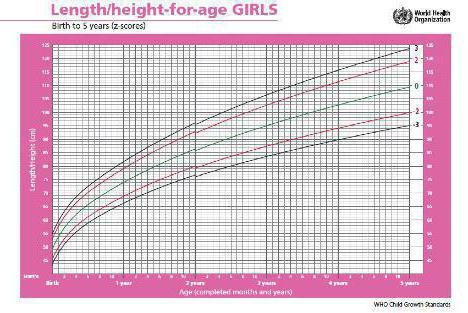The norm of weight and height of the child during the first year of life
Anthropometric indicators or the norm of weight andgrowth of the child - the most important criteria for assessing its natural development during the first year of life. Of course, these data are purely individual. Some children grow up in a measured way, they are gradually gradually gaining weight and growth. Others - abruptly. Such babies can then fall behind in weight in one month, but completely compensate for the shortage in another. They can grow slowly, then immediately after a month they will gain 7-9 centimeters. There is no concept of a "uniform rate of growth and weight of a child". Each organism develops in accordance with its internal rhythm - the biological clock.

1. If the mother does not have enough milk, or his nutritional value is low, the baby will not eat up, which can negatively affect the health of the child, it will be seen on the indicators. He will grow poorly and will not be able to gain weight. In this case, immunity may be weakened, and the child will be prone to diseases and serious vices in development. To avoid such threats to the life of the baby, his mother will be prescribed a diet that increases the fat content of milk. If this does not help, the child will have to give the lure.
2. If the baby is completely on artificial feeding, he quickly gaining weight. This does not mean that the mixture is better than breast milk, it's just that they are absorbed longer and do not have such a rich composition as mother's milk. The norm of weight and height of the child who is on artificial feeding, is a little higher, than at usual kids. Children up to a year each month should be examined by a doctor. This allows you to monitor the development and mark anthropometric indicators.

Factors affecting indicators
Among all the factors that can affect the weight and height of the baby, you should highlight the most common. Most often these are conditions that can not be taken into account by standards:
1. The environment. If it's summer heat, it's unlikely the kid will want to eat much. Most likely, he will try to drink more fluids. This can lead to a lag in the weight. Do not worry about this, because if the baby is active and alert, then it's healthy. A healthy baby should not cause parents anxiety, even if they do not want to eat. Just need to try to feed him at night, when the heat was asleep.
2. Gene predisposition. Very often babies are larger or smaller than the prescribed rate of height and weight. This may be due to the fact that their parents are different from the average statistical indicators. If the parents are small and have a fast metabolism, then it is likely that the baby will also slowly gain grams and centimeters. Conversely, large parents often have children, which significantly exceed the norms of growth and weight. But this is not a regularity. Sometimes, regardless of parents and genetic predispositions, a child can have standard indicators.

4. Diseases. Children are very sensitive to all changes in their body. The slightest cold can significantly reduce the absorption of food and, as a result, lead to a slowdown in development. Of course, this is not necessary, but often there are cases when even because of the cutting teeth in children, the appetite greatly deteriorates, the temperature rises, and the baby is gaining not enough weight in a month. Therefore the norm of weight and height of the child always have not one value, but limiting parameters.
</ p>>




